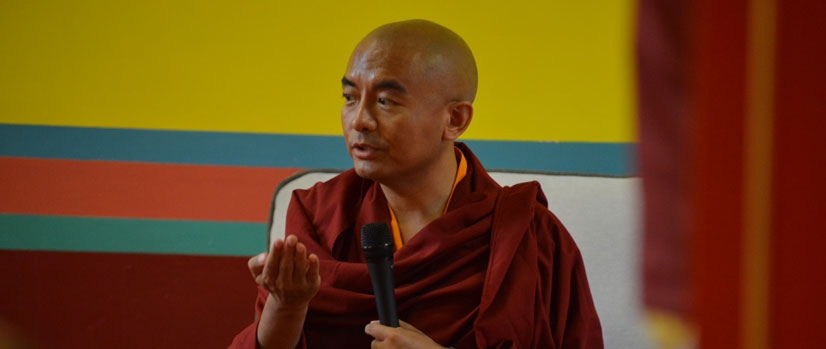
"It is true that meditation is important in the Buddhist tradition. There’s no question about that. The same can be said about studying Buddhist ideas and philosophies. But in many ways, ethics and virtue are the foundation of the Buddhist path."
- Yongey Mingyur Rinpoche
As a Buddhist teacher, I am often asked questions about meditation and profound Buddhist principles, like interdependence and emptiness. I am happy to share what I know on these topics. But I have noticed that people rarely ask me about ethics and how to live a virtuous life.
It is true that meditation is important in the Buddhist tradition. There’s no question about that. The same can be said about studying Buddhist ideas and philosophies. But in many ways, ethics and virtue are the foundation of the Buddhist path.
The Buddha himself lived a life of kindness, humility, and compassion. He fully embodied the teachings he gave, and the sangha that grew around him followed his example. There were many times when the students got off track and acted inappropriately—sometimes hilariously so—but these incidents were used as opportunities to clarify important values and to show the community how to live a life of virtue. From the early days of Buddhism, ethical conduct was as central to the path as meditation, study, and contemplation.
These days, the one time people do ask me about ethics is when scandals or controversies happen in Buddhist communities. Despite the clear importance of nonviolence and compassion in the Buddhist tradition, many students are not sure how to deal with these situations. I can see why they get confused. There are many different Buddhist lineages and schools, and it is hard to keep track of all their different teachings, practices, and ethical frameworks.
This is especially true in the Tibetan tradition, where we have three different approaches—which we call yanas or “vehicles”—that are woven together into one path of Buddhist practice. These are the Foundational vehicle of individual liberation, the Mahayana vehicle of great compassion, and the Vajrayana vehicle of indestructible wakefulness. This combination is one of the unique and beautiful aspects of Tibetan Buddhism, but it doesn’t always make things simple.
Ethics in Tibetan Buddhism
In Tibetan Buddhism we practice the three yanas together, and that includes the practice of ethics. Let me clarify.
The most basic ethical principle in the yana of individual liberation is nonviolence, the commitment to avoid harming others at all costs.
When we add in the Mahayana, we do not forget about nonviolence, but take it one step further with the practice of bodhichitta. This is the commitment to help all beings become fully enlightened.
Finally, Vajrayana brings in the notion of pure perception. In practicing the Vajrayana, we remain firmly grounded in nonviolence and the altruistic motivation of bodhichitta, but take the fruitional view. We treat everyone and everything as the embodiment of awakening. We commit ourselves to seeing ourselves, others, and the world around us as fundamentally pure, complete, and perfect.
This ideal of pure perception is embodied in the principle of samaya, the formal commitments that a Vajrayana practitioner adheres to. There many details about samaya, but simply put the essence of samaya is to practice pure perception to the best of one’s ability.
Many people misunderstand samaya and think it refers only to seeing the teacher as a buddha, a fully awakened being. That is part of samaya, but it misses the key point. Samaya is about seeing everyone and everything through the lens of pure perception. The sole purpose of viewing the teacher as a buddha is so we can see these same awakened qualities in ourselves, in others, and in the world around us. It is a tool that helps us to gain confidence in the purity of our true nature.
Vajrayana practice is rooted in the ideals of nonviolence and great compassion. There is no Vajrayana without them. So how do we use these principles to guide us on important issues like finding an authentic teacher and working with the inevitable challenges that arise in the life of a community?
Finding a Genuine Teacher
When it comes to finding a genuine teacher, there are four things that are especially important.
The first is that the teacher should be part of an authentic lineage. Genuine teachers do not promote themselves; they promote their lineage. If a teacher brags about their qualities and realization and makes a show of their practice, that is probably an indication that something is not quite right. But if a teacher has studied and practiced under the guidance of other respected teachers, and honors their lineage by upholding its values and traditions, that is a good sign. Lineage alone does not make a teacher genuine, but it is important.
The second quality to look for is commitment to study and practice. This one is pretty obvious. You would not take piano lessons from someone who’s not a good player themselves, would you? Of course not. The same is true here. If you are trusting someone with your spiritual well-being, you should be sure that this person knows the path first-hand. In order to do this, they should have a clear commitment to their own practice and training.
The third essential quality is compassion. As students, we need to feel confident that our teacher is on our side—that they have our best interests at heart and deeply care about us and our progress on the path.
Trust is critical here. A genuine teacher is trustworthy and puts the needs of the student first. The sign of a teacher who has this quality is that students feel safe and protected in their care. They know that no matter what is going on in their life, their teacher will always be there to guide and support them.
The fourth and final quality is the one that relates the most directly to ethics. A genuine teacher should uphold their vows and precepts. In the Tibetan tradition, that means they maintain whatever monastic or lay vows they have taken, adhere to the bodhisattva vows of the Mahayana, and keep the samaya vows of the Vajrayana.
This is no small feat, but it is very important. There are lots of details included in this one, and as students we may not know exactly what vows a person holds. But we can ask around and check to see if there are any questions about a teacher’s behavior or conduct. That is a good place to start.
In this day and age, it is not easy to find a perfect teacher. The time of the Buddha, when people seemed to get enlightened just by showing up, is long gone. We may not find a teacher who perfectly embodies all four of these qualities, but they should have all of them to some degree. If a teacher is completely lacking one or more of these qualities, it is probably best to move on.
Leaving a Teacher
These four qualities are a good general guideline to follow when looking for a teacher. But even when we do our best to research a teacher first, often we only really get to know the teacher after becoming their student. In the modern world, most of us do not have a monastery or Buddhist expert down the street. We do not necessarily know all the details about a teacher, or even have someone we can ask. So what do we do when we discover that a teacher is not quite what we hoped?
Many students of Tibetan Buddhism mistakenly think that they cannot, or should not, leave a teacher once they’ve made a commitment to them. This is not the case. The whole point of the teacher–student relationship is that it should benefit the student. It is not for the teacher’s gain or profit. If you have tried your best and have found that it is not a good fit, you can look for another teacher. This is not a problem or personal failing. It is good judgment.
The best way to leave is to do so without bad-mouthing the teacher or creating difficulties for those who may be benefiting from the teacher and the community. Leave on good terms, or at the very least, do not leave on bad terms. Simply move on with humility and do not feel bad about the fact that it did not work out.
The one caveat I would add here is that it is important to be honest with yourself. Leaving a teacher or community that does not seem to be a good fit is understandable, but if you find every teacher unworthy of your time, then you may want to look deeper into your own patterns to see what is going on. It may be difficult to make any progress on the path if you are looking for perfection.
Read the full article in The Lion's Roar.
Read the full article in Portuguese.
Read the full article in German.
Read the full article in Spanish.


0 responses on "Treat Everyone as the Buddha"